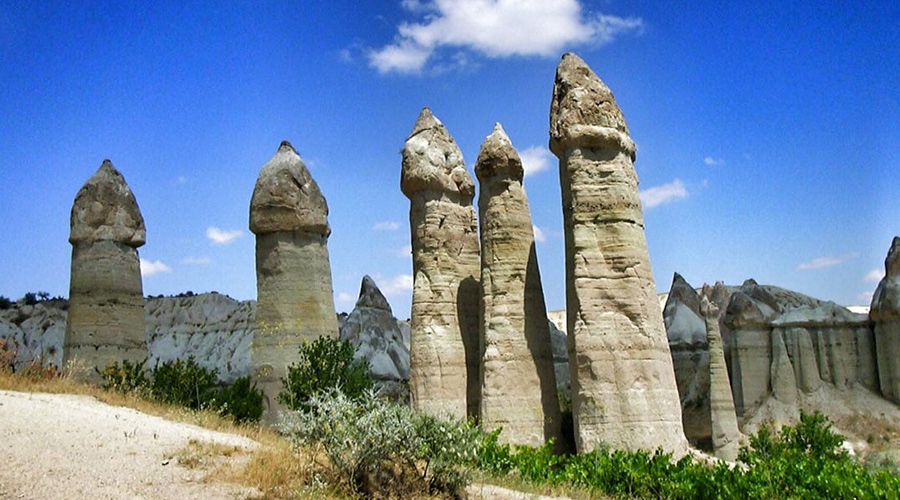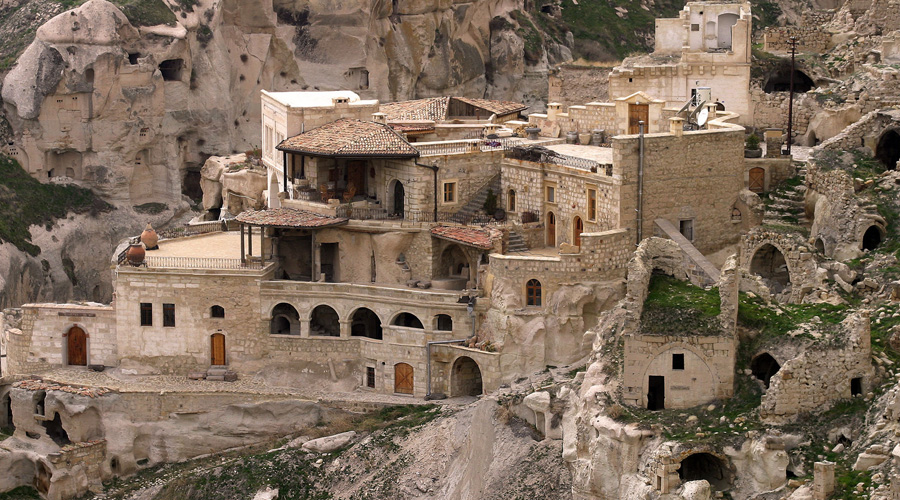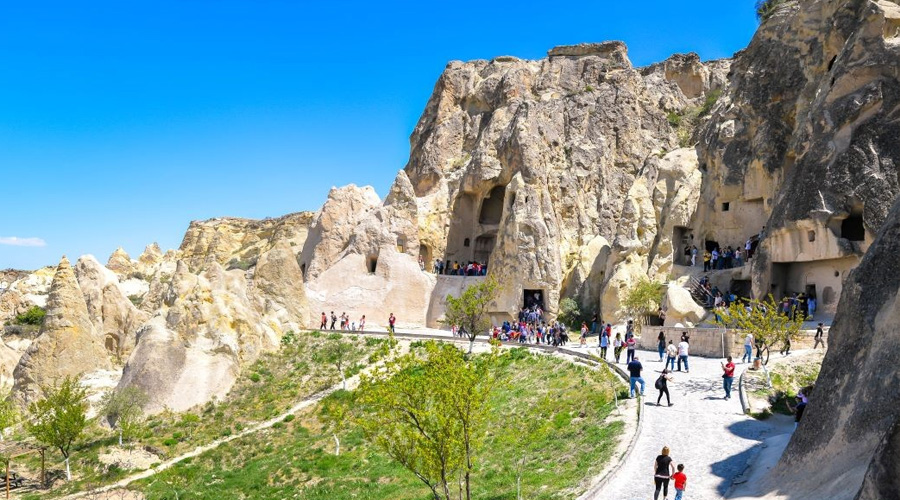Cappadocia or Kapadokya, whose name means ‘Katpatuka – Land of Beautiful Horses’ in Persian, is Turkey’s one of the most visited tourism centers. Cappadocia, which was included in the World Heritage list by UNESCO in 1985, dates back 60 million years.
Geographical Location of Cappadocia
Cappadocia is the region that emerged when the soft layers formed by lava and ashes erupted by Erciyes, Hasandağı, and Göllüdağ Mountain 60 million years ago. It was eroded by rain and wind over millions of years. Although these 3 different mountains were shaped by different resistances in different time periods, they first completed their formation and reached different heights. This tuff layer is partially covered with a thin layer of lava consisting of basalt and after a while the basalt cracks and breaks into pieces. The waters leaking from the cracks with the rains begin to erode this soft tuff layer, and the air that first warms and then cools down joins the formation as wind support. As a result of these interactions, cones with caps are formed from basalt rocks. These rocks, which have different and interesting shapes, are called “fairy chimneys (peribacaları in Turkish)” by the people. The tuff layers without basalt cover turn into valleys with the support of erosions. The volcanic material that emerged as a result of volcanic movements covers the valleys and hills formed by moving towards the collapsed regions and turns the view of the region into a plateau. The Fairy Chimneys, which were formed as a result of the two opposing forces of nature shaping the geological structure one after the other, are the main reason why the Cappadocia region has a unique geography in the world, and it spreads over an area of approximately 288 km² surrounded by volcanic mountains and Kızılırmak.
If we describe the Cappadocia region in terms of its province, Nevşehir province is in the middle of Anatolia, on the ashes and lava of extinct volcanoes such as Erciyes, Melendiz, and Hasandağları, the longest river in the country, Kızılırmak, carved from east to west, and the side waters that mix with the Kızılırmak river from the north and south. It is located on a plateau spread over a very wide area in the valleys that it opens. The city center was established on the western slopes of these wide and high plains. Acıgöl, Avanos, Derinkuyu, Gülşehir, Hacıbektaş, Kozaklı and Ürgüp are among the districts of Nevşehir province.
The Story Behind Cappadocia
The geographical formation of Cappadocia begins with the rise of the Taurus Mountains 60 million years ago in the 3rd geological time and continues with the cracks and collapse areas formed in the region in the 2nd half of the 3rd time, during the Neogene period. With the compression of the Anatolian Plateau in the north, the volcanoes become active and the ashes accumulated on the plateau form a soft tuff layer with the lava eruption of Erciyes, Hasandağı, and Melendiz Mountain.
The Role of Cappadocia For Tourism
In the Cappadocia region, nature and history are integrated. While geographical events were creating the Fairy Chimneys, people carved houses and churches into these fairy chimneys, decorated them with frescoes, and carried the traces of thousands of years of civilizations to the present day. The written history of Cappadocia begins with the Hittites. Additionally, human settlements date back to the Paleolithic period. Cappadocia has hosted trade colonies throughout history. It established a commercial and social bridge between countries. Moreover, it is also one of the important crossroads of the Silk Road.
The region has a great importance in terms of tourism today. Ürgüp, Avanos, Göreme, Akvadi, Uçhisar and Ortahisar Castles, El Nazar Church, Aynalı Church, Güvercinlik Valley, Derinkuyu, Kaymaklı, Özkonak Underground Cities, Ihlara Valley, Selime Village, Çavuşin, Güllüdere Valley, Paşabağ and Zelve are the main places to visit and see.
Cappadocia is an outstanding place because traditional Cappadocian houses and dovecotes carved into the rocks express the authenticity of the region. For these houses, rocks and cut stones were used. Moreover, they were built on the slopes. Stone, which is the only architectural material of the region, can be processed very easily because it is soft after coming out of the quarry due to the volcanic structure of the region. After contact with air, it hardens and turns into a very durable building material. Due to the easy processing of the material used, the stonework, which is unique to the region, has developed and has become an architectural tradition. Stylized ivy or rosette motifs were used for the upper part of the arched doors. The dovecotes in the region are small structures built in the late 19th and 18th centuries. Some of the dovecotes, which are important in terms of showing the art of Islamic painting, were built as monasteries or churches. The surface of the dovecotes is decorated with rich ornaments and inscriptions by local artists. Winemaking and grape growing are also famous activities in the Cappadocia region.
Things To Do In Cappadocia
• Ürgüp
Ürgüp, 20 km east of Nevşehir, is one of the most important centers of the Cappadocia Region. Ürgüp has had many different names for hosting many different civilizations in the historical process. Osiana (Assiana) in the Byzantine Period, Başhisar during the Seljuk Period, Burgut Castle during the Ottomans, and finally it has been called Ürgüp since the first years of the Republic.
Ürgüp, which has a geological structure of volcanic origin, was established in a region where frequent and typical examples of interesting natural formations, which are defined as fairy chimneys and caused by rain and wind erosion, are densely located. The fairy chimneys rising between the crevices formed as a result of the erosion of the rainwater flowing from the valley slopes and then the winds have created a very interesting landscape view unique to this region.
The first settlement in and around Ürgüp is the skirts of Avla Mountain to the east of the Damsa Stream, whose ancient name is Tomissos. As a result of the survey conducted by British Archaeologist Ian Todd here, tools from the Paleolithic Period made of many obsidian and silex were found. The most important remains of later periods are the Roman Period rock tombs found in the towns and villages of Ürgüp. Ürgüp, which was also an important religious center during the Byzantine Period, was the episcopacy center of the rock churches and monasteries in its villages, towns, and valleys.
• Derinkuyu Underground City
Derinkuyu Underground City, which is the largest underground city in Cappadocia, reaching a depth of eighty-five meters and spreading over a wide area, has been introduced to the tourism sector since 1967. There is also the oldest mental hospital in the world around Derinkuyu, which has 8 floors. In Derinkuyu Underground City, there are tunnels, also. Although the city is thought to have 12 or 13 floors, 8 floors are open to visitors for now. Derinkuyu Underground City has all the features of the underground cities found in the Cappadocia region, but unlike the Kaymaklı Underground City, which has a lot of similarities, there is also a missionary school, a confessional place, a baptismal pool, and an interesting well.
• Göreme Open Air Museum
It is said that monastic life was experienced between the 4th and 13th centuries AD in Göreme Open Air Museum, which is 13 km away from Nevşehir city center. There are churches, dining halls, chapels, and sitting areas in the open-air museum. Historical textures from various periods are also included in the monasteries and chapels in the region. Additionally, Göreme Open Air Museum has been on UNESCO’s World Heritage List since 1985.
What Else Can You Do in Cappadocia?
There are other things to do in Cappadocia, also. Let’s see them together!
- The Monasteries of the Virgin Mary and Girls, St. Barbara, Elmalı, Yılanlı, Çarıklı, Karadağ and Tokalı churches are decorated with the frescoes. In Göreme, which is 12 kilometers away from the city center, you can also enter the Kılıçlar Valley, photograph the fairy chimneys, and take a walk in the Love Valley.
- Paşabağ Valley is one of the most visited places in Cappadocia where fairy chimneys can be seen best. In the valley, which was used as a hermitage by monks during its time, there are many rock-cut monasteries, churches, chapels and settlements, as well as structures such as tunnels and mills.
- You can watch the sunset from the windy summit of Uçhisar Castle, 2 kilometers away from the center of Nevşehir. It will be a great experience for you!
- You can enjoy the hot air balloon. In Cappadocia, it will be one of the moments when you feel most free to pass through the clouds and see the valleys flowing through the fairy chimneys below, fluctuate according to the pleasure of the wind and descend wherever the wind feels like. Maybe you can contact the companies working professionally in the region to join the Cappadocia balloon tour and get further information about Cappadocia balloon price.
- You can make pottery in Avanos. In the workshops which you will see in abundance in the center of Avanos, you will first see what the master and then the artist can do. Sitting by the wheel and watching the clay take shape between two palms, turning into a vase or a jug, you will be proud of ‘I made it’. Come on, get your hands on the mud and start showing your artistic side!
- You can explore the flavors of Cappadocia cuisine. In Cappadocia, you can find a selection of world cuisine, as well as dishes that have benefited from the essence of Central Anatolian cuisine and are flavored with the skills of the local people. But if you are looking for ‘exclusivity’, there are a few special presentations that we say you must try. Although testi kebab is a flavor that enters the region from outside, its cooking and presentation is completely unique to Cappadocia. Tandoori is a special cooking method in the Cappadocia region. It is more delicious because the meat is cooked for a long time. Even dried beans will taste different when you eat them at one place. In addition to its kebabs, you may taste the dishes such as stuffed quince, dıvıl, kömbe and sızgıt.
- You can attend Turkish night shows. Especially in Uçhisar and Avanos, the Turkish nights in Cappadocia, which are organized to promote Turkish culture and have fun, attract a great deal of interest from foreign tourists. You will have fun by watching different dances from whirling dervishes to oriental, fasil to folklore in the underground restaurants carved from very large rocks. While you are having fun, you will be impressed by the local cuisine’s delicious dishes and quality wines, as well as the atmosphere of the places unique to Cappadocia.
- You can stay in cave hotels in Cappadocia. If your expectations are for comfort in accommodation, you will wake up with a view overlooking the valleys in the regionally themed cave rooms in Uçhisar, with the most luxurious hotels in the world rankings. There are plenty of locally arranged stone houses in Cappadocia. If your budget is suitable for more modest accommodation, you must try them. You will experience both the traces of old life and its harmony with modernity, and you will say ‘good morning’ to the most beautiful mornings in the world here.
- You may buy souvenirs for your loved ones who are very curious about Cappadocia but couldn’t come and visit this region.
Let’s reply to short questions
• What is your advice to stay: Cappadocia cave hotels
• Best hotel in Cappadocia: We advise you to check the review of the hotels of Cappadocia.





